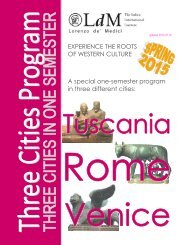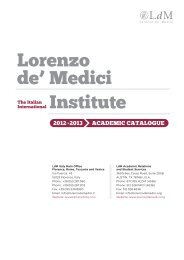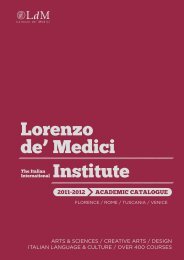aCademiC Catalog 2013-2014 - Lorenzo de Medici
aCademiC Catalog 2013-2014 - Lorenzo de Medici
aCademiC Catalog 2013-2014 - Lorenzo de Medici
You also want an ePaper? Increase the reach of your titles
YUMPU automatically turns print PDFs into web optimized ePapers that Google loves.
School of Arts & Sciences ROME<br />
contemporary and later artists. The course will also explore<br />
relations with his commissioners, especially the <strong>Medici</strong> in<br />
Florence and the papal court in Rome un<strong>de</strong>r pope Julius II.<br />
Stu<strong>de</strong>nts will gain a <strong>de</strong>tailed knowledge of Michelangelo’s work,<br />
and will be able to i<strong>de</strong>ntify and analyze major works in painting,<br />
sculpture and architecture. Site visits will form an essential part<br />
of the course.<br />
Prerequisites: ART 180 Art History I, or ART 186 Art History II,<br />
or equivalents<br />
Italian Villas and Gar<strong>de</strong>ns<br />
ART 282 R<br />
Cr: 3; Contact hrs: 45<br />
This course examines the <strong>de</strong>velopment of Italian villa and<br />
gar<strong>de</strong>n architecture from ancient Roman times to the present.<br />
This course covers these artistic periods: 1) Ancient Rome;<br />
2) Medieval; 3) Renaissance and Mannerism; 4) Baroque;<br />
5) Romantic; 6) Mo<strong>de</strong>rn. Special emphasis is placed on the<br />
Renaissance, and on Florentine, Tuscan and Roman villas and<br />
gar<strong>de</strong>ns. Lectures and visits illuminate the intimate relationship<br />
between the villa, its formal gar<strong>de</strong>ns, and the surrounding<br />
environment. The course examines structures and grounds in<br />
terms of architectural <strong>de</strong>sign, typical features of each period<br />
(paintings and statues, fountains, grottoes, plants), and<br />
conceptual and symbolic meanings. The course will also explore<br />
the social and aesthetic function of villas and gar<strong>de</strong>ns: “magic<br />
places” in which nature and culture, work and pleasure meet.<br />
The aim of this course is to offer stu<strong>de</strong>nts a comprehensive<br />
look at the history and character of Italian villas and gar<strong>de</strong>ns,<br />
in the process familiarizing them with Italian ways of life and<br />
thought.<br />
Prerequisites: ART 165 History of Architecture, or ART 180 Art<br />
History I, or ART 186 Art History II, or equivalents<br />
Art and Architecture of Ancient Rome<br />
ART 315 R; Dual listed: CLA 318 R<br />
Cr: 3; Contact hrs: 45<br />
This upper level course examines the major <strong>de</strong>velopments in the<br />
art and architecture of ancient Rome from the foundation of the<br />
city to the age of Constantine, with an emphasis on significant<br />
examples of Roman monumental buildings and works of art,<br />
crucial archaeological sites, and newly excavated areas. In<br />
addition to introducing stu<strong>de</strong>nts to analysis and interpretation<br />
of styles, this course addresses a variety of current themes and<br />
topics such as public and private architectural spaces, urban<br />
planning, traditions, innovations, patronage, past and current<br />
meaning of Roman art. The emphasis is on investigating Roman<br />
art and architecture in relation to cultural, political, social, and<br />
economic <strong>de</strong>velopments and through an interdisciplinary<br />
approach. To facilitate the un<strong>de</strong>rstanding of the multifaceted<br />
aspects of Ancient Rome, conventional classroom lectures are<br />
supplemented with field trips to museums, archaeological sites,<br />
and excavations in progress.<br />
Prerequisites: ART 180 Art History I, or ART 186 Art History II,<br />
or equivalents<br />
Art and Architecture of Medieval Rome<br />
ART 325 R<br />
Cr: 3; Contact hrs: 45<br />
This upper level course investigates the art and architecture<br />
of medieval Rome between the years 313 and 1308. In Rome,<br />
remaining churches allow to discover the major medieval<br />
periods and styles (Byzantine, Romanesque, Gothic) and<br />
consi<strong>de</strong>r them in relation to the most representative medieval<br />
buildings in Italy. In addition to introducing stu<strong>de</strong>nts to<br />
analysis and interpretation of medieval buildings, images, and<br />
sculptures, this course addresses a variety of themes and topics<br />
such as the power of icons and relics, the conflict between the<br />
Papacy and the Empire, pilgrimage, crusading, monasticism,<br />
and liturgical processions. The emphasis is on studying the<br />
impact of cultural, political, economic, and social changes in<br />
the creation of art and architecture during the early and high<br />
Middle Ages. The course also reconstructs the “image” and<br />
cityscape of medieval Rome with its religious lea<strong>de</strong>rs and<br />
multiethnic society while examining, among other issues, the<br />
strategies <strong>de</strong>veloped to visually promote the Papacy, the causes<br />
for monastic popularity, the renewal of classicism during the<br />
Carolingian period and the age of Fre<strong>de</strong>rick II. To facilitate the<br />
un<strong>de</strong>rstanding of the multifaceted aspects of medieval Rome,<br />
conventional classroom lectures are supplemented with visits<br />
to churches and other ecclesiastical buildings.<br />
Prerequisites: ART 180 Art History I, or ART 186 Art History II,<br />
or equivalents<br />
High Renaissance and Mannerism<br />
ART 340 R<br />
Cr: 3; Contact hrs: 45<br />
This course traces the major trends of Italian art in the sixteenth<br />
century. It is a period dominated by the achievements of<br />
Leonardo da Vinci, Raphael, Titian, and above all, Michelangelo.<br />
These three artists are examined in great <strong>de</strong>tail. This analysis<br />
is not confined to their works of art, but also inclu<strong>de</strong>s their<br />
personalities and the social framework within which they<br />
lived and worked. Great emphasis is therefore put on the dual<br />
themes of patronage and the social position of the artist in<br />
the period. The course also explores the complex and refined<br />
style known as Mannerism - a style held to have emerged from<br />
ten<strong>de</strong>ncies present in Michelangelo’s work. Stu<strong>de</strong>nts learn to<br />
i<strong>de</strong>ntify and examine in <strong>de</strong>tail the works of the leading artists<br />
of the period, and gain the ability to discuss High Renaissance<br />
and Mannerist <strong>de</strong>velopments of major subjects and genres,<br />
such as portraiture and the nu<strong>de</strong>. In the host city stu<strong>de</strong>nts visit<br />
various unique churches, galleries, resi<strong>de</strong>nces, and squares<br />
related to the period, and examine in person masterworks by<br />
representative artists.<br />
Prerequisites: ART 180 Art History I, or ART 186 Art History II,<br />
or equivalents<br />
Baroque Art<br />
ART 350 R<br />
Cr: 3; Contact hrs: 45<br />
This course covers the Baroque style in art and architecture,<br />
with with particular emphasis on seventeenth-century Italy. This<br />
consi<strong>de</strong>ration of Baroque art is not only limited to a stylistic<br />
analysis but involves continual reference to the religious,<br />
political, cultural and social framework of the period. The<br />
social rise of the artist in the seventeenth century is illustrated<br />
through the career of Bernini. Special focus is placed on major<br />
artists including Carracci, Caravaggio, Bernini, Borromini,<br />
Pietro da Cortona and their workshops, and on their role in the<br />
<strong>de</strong>velopment of a wi<strong>de</strong>r Italian and European artistic language.<br />
Stu<strong>de</strong>nts will become familiar with the main characteristics<br />
of the Baroque style and with key issues and trends and<br />
issues, such as iconography and emblem culture, Naturalism,<br />
Classicism, and Triumphalism.<br />
Prerequisites: ART 180 Art History I, or Art History II, or<br />
equivalents<br />
Italian Contemporary Art<br />
ART 353 R<br />
Cr: 3; Contact hrs: 45<br />
The course focuses on Italian art of the 1950s, ‘60s, ‘70s, and<br />
‘80s analyzing movements and artists whose work represents a<br />
dialogue with international <strong>de</strong>velopments, from Abstraction to<br />
Informale, from Arte Povera to Transavanguardia. The course is<br />
divi<strong>de</strong>d into a first part analyzing movements and artists, and a<br />
second part examining places and personalities representative<br />
of the experience of Italian Mo<strong>de</strong>rn Art. Artists studied inclu<strong>de</strong><br />
Renato Guttuso, Renato Schifano, Mimmo Paladino, and<br />
Francesco Clemente. The course has a specific focus on Rome<br />
as a city of uninterrupted exchange with other Italian centers<br />
(such as Milan, Naples, Turin) and the international panorama,<br />
thanks also to gallery owners and critics such as Ugo Ferranti,<br />
Mario Pieroni, Fabio Sargentini (who introduced American<br />
artists and Conceptual art), Germano Celant and Achille<br />
Bonito Oliva, and to major international exhibitions such as<br />
Contemporanea and Vitalità <strong>de</strong>l Negativo.<br />
Prerequisites: ART 180 Art History I, or ART 186 Art History II,<br />
or equivalents<br />
Avant-gar<strong>de</strong> and Mo<strong>de</strong>rnist Art (1900-1950)<br />
ART 370 R<br />
Cr: 3; Contact hrs: 45<br />
The course examines conceptual and stylistic trends in<br />
European and American art in the first half of the 20th<br />
134<br />
LdM Aca<strong>de</strong>mic <strong>Catalog</strong> <strong>2013</strong>-<strong>2014</strong>





